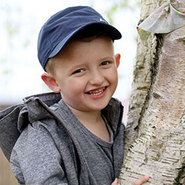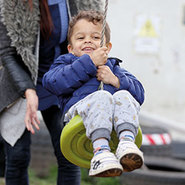
Download the PDF of this article
Adventurous play involving risk and challenge is a long-standing feature of provision for young children. Friedrich Froebel, the inventor of the kindergarten, argued that children should have opportunities for being ‘brave and daring’ in their play. He observed children’s desire to seek their own challenges and to enjoy overcoming obstacles indoors and outdoors.
Margaret McMillan, another pioneer of nursery education, noted children’s desire to play ‘bravely and adventurously’. She advocated a ‘provocative environment where new chances are made possible’ (in Tovey 2017). Climbing trees, using real tools, digging in the garden, creating rivers and dams and building large-scale constructions were valued in both Froebel and McMillan’s environments.
But where is the adventure and challenge in children’s play today? As play is increasingly vulnerable to targets and outcomes, constrained by demands for ‘school readiness’ amid a prevailing climate of risk aversion, it is timely to look critically at our environments and reflect on how challenging and ‘provocative’ they really are.
RISK: WHAT IS IT?
Risk is not something fixed and certain; rather there are perceptions of risk. What is an acceptable risk for one child may be a hazard for another. What is acceptable in one context may be unacceptable in another. Our culture, experience and even gender are likely to influence how we perceive something as safe or too risky. This means it is vital that we reflect critically on our own attitudes to risk.
Risk-taking is about uncertainty and possibility. It requires some assessment of the degree of challenge involved in the risk against one’s own confidence and capability. It involves weighing up the benefits of the activity against the possible negative outcomes.
However, to many people the word ‘risk’ is associated not with benefits but with danger. Risk is seen as something undesirable, to be assessed, managed, controlled or eliminated, in the pursuit of creating a ‘safe’ environment. Paradoxically, the biggest risk is that there is no risk at all.
Risk is part of being alive and being human. Life is full of varied risks and we have to learn to recognise and manage them. Risk-taking is not just about physical risks, although these might be the ones that worry us most. Children take social risks; for instance, when they try to join in an established game, as the risk of rejection is high. Risk underpins creative, imaginative and scientific thinking. We ‘hazard’ a guess, ‘dare’ to be different and take ‘imaginative leaps’ in our thinking.
SO WHY IS RISK-TAKING IMPORTANT?
Playing adventurously in a challenging environment motivates children to extend their own boundaries, to explore a little further, to develop a disposition to persist at something and see challenges as problems to enjoy.
The willingness to initiate activities, seek challenges, take risks, show a can-do attitude and learn from mistakes are important characteristics of an effective learner. There is a danger that when we repeatedly say to children ‘mind out’, ‘be careful’, ‘come down, you’ll fall’, we can inadvertently undermine these important learning dispositions.
There is evidence that risk and challenge in a supportive environment is positively linked with emotional well-being, resilience and mental health. Managing a small amount of fear and uncertainty, such as balancing along a wobbly bridge or sliding fast down a steep slope and holding your nerve when feeling on the edge of ‘out of control’, are important aspects of emotional well-being. Such play can develop children’s resilience and help them cope physically and emotionally with unexpected events.
Vigorous adventurous play such as climbing high, swinging, sliding, rolling and hanging upside down where the normal body position is altered, are fundamental for learning. For example, children experience important mathematical and scientific concepts of gradient, gravity, speed, distance, height, position, space, stability and balance.
Creating an environment for risk and challenge
 Risk and challenge do not thrive in static, pre-packaged, plasticised environments which are overly dominated by an adult agenda. Rather they thrive in sensory-rich, dynamic environments which are flexible, transformable and responsive to children’s changing interests.
Risk and challenge do not thrive in static, pre-packaged, plasticised environments which are overly dominated by an adult agenda. Rather they thrive in sensory-rich, dynamic environments which are flexible, transformable and responsive to children’s changing interests.
All areas of the environment are important. Children can be adventurous block-builders, constructors, creators and explorers, and players indoors as well as out.
What is an appropriate environment will depend on the age and experience of children and the context of the setting. Nevertheless, an environment supportive of risk, challenge and adventurous play is likely to include these features:
A transformable environment which is responsive to children’s changing interests and which children can act on and change.
A flexible environment to provide sufficient challenge for the more hesitant and the more adventurous.
A positive can-do ethos where adults support children in what they are trying to achieve, respect their desire to do things for themselves and trust their growing competence.
Freedom, choice and autonomy within a framework of guidance. The freedom to choose resources, to create their own challenges and to seek and solve their own problems with support from adults.
Sufficient time and space for children to explore, experiment and try things out.
Such an environment might include:
 Experiences of nature such as trees, bushes, plants, small creatures, earth, fire, air and water.
Experiences of nature such as trees, bushes, plants, small creatures, earth, fire, air and water.
Open-ended resources such as blocks, sand, water, clay and recycled materials. These have no fixed, required ways of using them, just many possibilities.
Opportunities for expansive whole-bodied movement with such things as rope swings, slides, rough ground, tunnels, jumping-off points and spaces for crawling, spinning and hanging upside down.
Experiences which children find enjoyably ‘scary’ such as balancing on a wobbly bridge, swinging in a hammock, exploring an overgrown ‘wild’ area or lighting a flame such as a candle.
Increasing use of real tools, such as whisks, hammers, saws, screwdrivers, hand drills, gardening tools, sewing tools and so on, with well-organised storage and appropriate adult support; a plentiful supply of things to take apart and investigate, such as a box of old clocks, plugs and radios.
However, ultimately it is the adults’ attitudes, not the resources, which make a real difference in satisfying children’s desire for risk and challenge. Adults who see children as adventure-seekers and risk-takers have realistically high expectations of children’s abilities and can help them to assess risk for themselves.
As Susan Isaacs, another of the great nursery pioneers, argued, ‘If you are going to keep children safe you must provide places where they can get the thrills they need…and can safely get the experience of adventure and the sense of challenge they crave’ (in Tovey 2007).
REFERENCES
Tovey H (2007) Playing Outdoors: Spaces and Places: Risk and Challenge. Oxford University Press
Tovey H (2017) Bringing the Froebel Approach to your Early Years Practice. David Fulton Publishers









